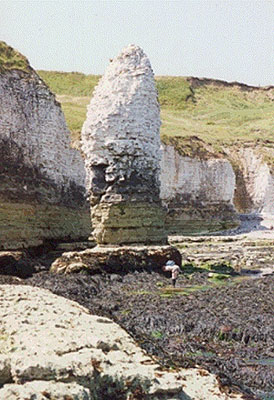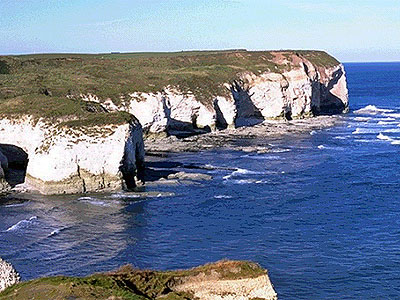Macro-algae functional groups as an assessment tool of biodiversity
Jean-Paul Ducrotoy
Institute of Estuarine and Coastal Studies,
University of Hull,
Filey Road,
Scarborough YO11 3AZ,
United Kingdom
 |
Chalk sea-stack near Flamborough Head on the
north-east coast of England
Traditionally, seaweed ecology has relied on the study of individual
species and the identification of assemblages. Alternatives to
ecological groups are functional groups. In 1975, a simple
classification system, using three morphological groups of algae, was
proposed by Dayton. Based on more detailed categories, Littler and
Littler (1980) proposed a functional form model to study trends in the
successional status of seaweeds. The model they developed integrated the
morphological attributes of the thallus in relation to the productivity
and the survival of benthic macroalgae. They applied the groups to a
subtropical rocky intertidal system and were able to relate the various
groups to the stability of the substratum (Littler & Littler, 1984).
Steneck & Watling (1982) confirmed that polyphyletic groups based on
the anatomical and morphological characteristics of the thallus could be
grouped to reflect ecological characteristics. More recently, Steneck
and Dethier (1994) studied sites from three biogeographical regions.
They suggested that the use of functional groups could provide insight
into the structure of communities and could be used to make comparisons
in space and time. Such studies have concentrated on the use of
functional groups for assessing the response of complex algal
communities to disturbances in subtidal environments (Lavorel et al.,
1997).
Rocky shores
Such a functional group approach has ecological application on
intertidal rocky shores (Tobin et al., 1998; Tobin, 2000). In a
preliminary survey of the Yorkshire coast (England), the authors were
confronted to the fact that the identification of seaweeds at species
level in such complex habitats requires a high level of taxonomic
expertise and is time consuming. Moreover, it was sometimes difficult or
even impossible to identify species in the field. Using several sampling
sites in North-East England, they showed that these difficulties can be
overcome by dividing the biota into functional groups They compared
species based and group based descriptions of algal-dominated shores.
They demonstrated that, on temperate rocky shores, the functional group
approach could help identifying large-scale factors affecting the
distribution and survival of marine macrophytes. They further showed the
utility of the functional group approach in temporal studies. Patterns
in community structure could be detected and a degree of stability
undetectable at species level could be highlighted.
Recolonisation
Following a land-slide which affected the intertidal rock platform,
functional groups were used for understanding recolonisation processes
of a degraded ecosystem. Looking for a simple protocol, Ducrotoy &
Pickaert (2001) suggested that the approach could rely on a simple
sampling strategy, including a reduced sampling effort, but could
describe recolonisation forces and help assessing progress in recovery.
The hypothesis to be tested was that, rather than occurring as a uniform
and progressive process, recolonisation would happen step by step and
imply successive attempts from plants to reinstall.
 |
Extensive chalk cliffs at Flamborough Head,
BIOMARE European Marine Biodiversity site.
Experiment
An experimental approach to this problem was made possible because a
large-scale disturbance took place in the intertidal area of a wave cut
platform where the hypothesis could be tested. In May 1993, the wave cut
platform at Holbeck, Scarborough (North Yorkshire, United Kingdom) was
impacted by a land slide from the overhanging cliff. Twenty thousand
tonnes of clay were deposited on the rocky shores within minutes. The
engineering works that took place over the following year resulted in a
complete removal of intertidal organisms over about a 1 ha area.
The simple groupings proposed by Dayton (1975) were adapted to the
situation found on the coast of North-East England. Because of its
simplicity and the confidence in assigning species to groups, results
could easily fit the model of the recolonisation (Sylvand &
Ducrotoy, 1998).
Digital photographs
In order to meet the requirements for monitoring the European Natura
2000 site at Flamborough Head, Ducrotoy & Simpson (2001) have
developed techniques based on the use of computer processed digital
photographs (Malone, 1997; Strong, 1998; Simpson, 1999). Such techniques
are now being used at other similar sites throughout Europe, notably SAC
and SPA designated under the European Directives (IECS
unpublished).
Flamborough Head is a candidate marine SAC. It was designated for the
chalk cliffs and sea caves under the EU Habitats and Species Directive,
a SPA under the EU Wild Birds Directive, a Heritage Coast, a Sensitive
Marine Area (SMA), a Site of Special Scientific Interest, and a Ramsar
Site. Recently, it was selected as a Flagship Site for intensive
research on biodiversity, in the framework of the European Concerted
Action BIOMARE.
Bibliography
Dayton, P.K., 1975. Experimental evaluation of
ecological dominance in a rocky intertidal algal community. Ecological
Monographs, 45: 137-159.
Ducrotoy, J.P. & Pickaert C., 2000. A
functional group approach to seaweed recolonisation of a wave cut
platform. Journal de Recherche Oceanographiques, 26: 43-56.
Ducrotoy, J.P. & Simpson S.D., 2001.
Developments in the application of photography to ecological monitoring,
with reference to alga beds. Aquatic Conservation: Marine and
Freshwater Ecosystems, 11: 123-135.
Lavorel, S., McIntyre, S., Landsberg, J. &
Forbes, T.D.A., 1997. Plant functional classification: from general
groups to specific groups based on response to disturbance. TREE,
12, (12): 474-477.
Littler, M.M. & Littler, D.S., 1980. The
evolution of thallus form and survival strategies in benthic marine
alga: Field and laboratory tests of a functional form model. American
Naturalist, 116 (1): 25-44.
Littler, M.M & Littler, D.S., 1984.
Relationships between macroalgal functional form groups and substrata
stability in subtropical rocky intertidal systems. Journal of
Experimental Marine Biology and Ecology, 74: 13-34.
Malone, R., 1997. A proposed methodolgy for the
long-term monitoring of the intertidal macroalgae on a wave-cut
platform, with specific reference to Selwicks Bay, Flamborough Headland,
North Humberside. Heritage Coast Report: 26 pp.
Simpson, S.D., 1999. A long-term monitoring
strategy for the algal beds at Selwicks Bay, Flamborough, England:
Unpublished Mres thesis, University of York.
Steneck R.S. & Watling L., 1982. Feeding
capabilities and limitation of herbivorous molluscs: a functional group
approach. Marine Biology, 68: 299-319.
Steneck, R.S. & Dethier, M.N., 1994. A
functional group approach to the structure of algal-dominated
communities. Oikos, 69: 476-498
Strong, E., 1998. Broad scale monitoring of a
macroalgal community at Selwicks Bay, Flamborough Head. Unpublished Mres
thesis, University of York.
Sylvand, B. & Ducrotoy, J.-P., 1998. Monitoring
coastal and estuarine systems: The need for an integrated approach. In:
With rivers to the Sea: Interaction of Land Activities, Fresh Water and
Enclosed Coastal Sea, Falkenmark M. (ed.), Stockholm International
Water Institute, Stockholm: 189-204.
Tobin, M., 2000. Applications of a functional group
approach to the study of temperate algal communities. Unpublished Dphil
Thesis, University of York.
Tobin, M.L., Scott, G.W. & Ducrotoy, J.-P.,
1998. Applications of a functional group approach to algal community
ecology. In: Changes in the marine flora of the North Sea, Scott
G.W. & Titley I. (eds.), CERCI, University College Scarborough:
135-147.
|
